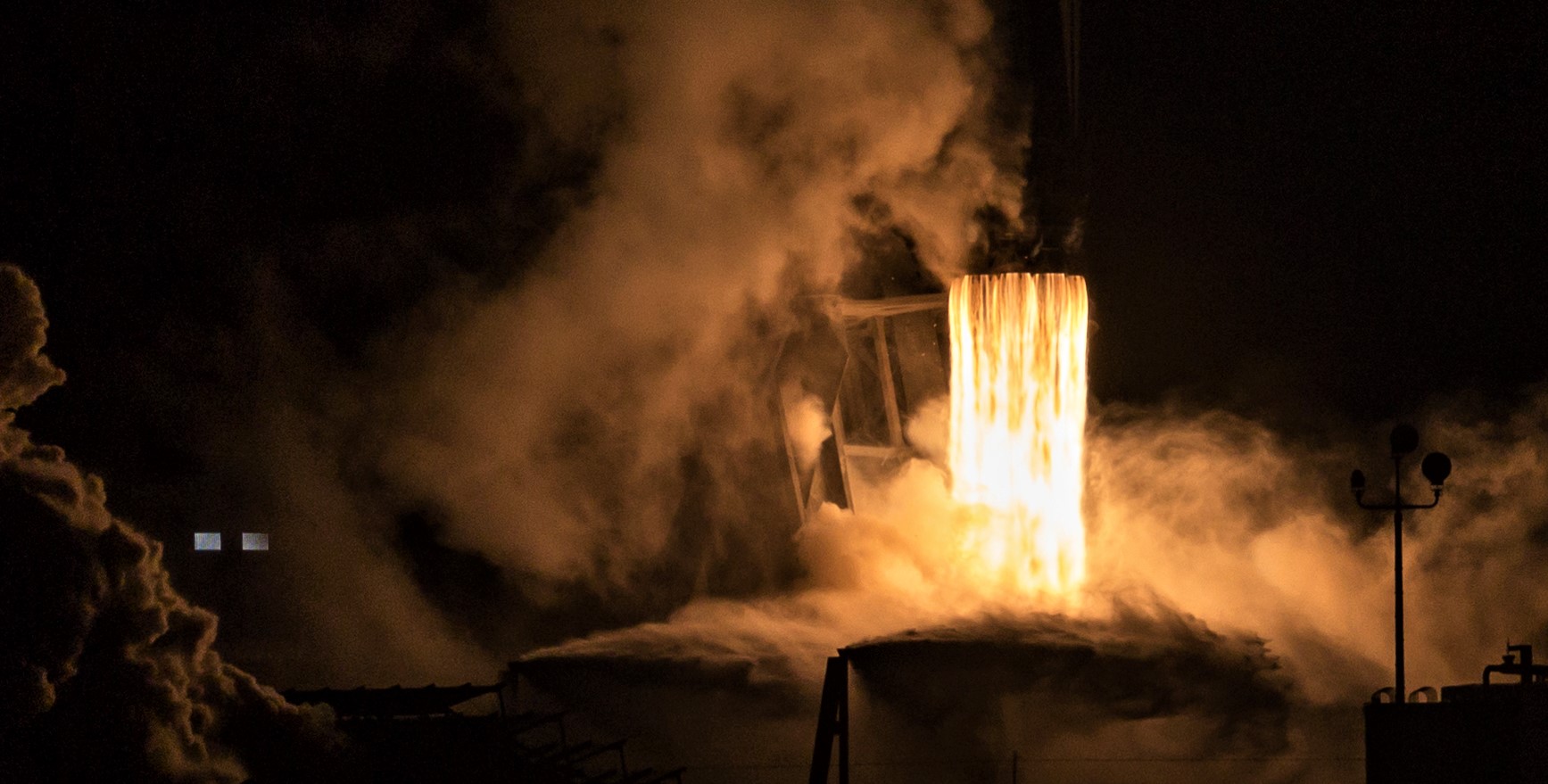

News
SpaceX Falcon 9 rocket tests engines for first launch and landing of the new decade
SpaceX has successfully fired up a Falcon 9 rocket for the first time in 2020, setting the company up for the first of potentially dozens of Starlink launches over the next 12 months.
On the afternoon of January 4th, SpaceX loaded Falcon 9 with hundreds of tons of liquid oxygen, refined kerosene (RP-1), nitrogen, and helium and ultimately ignited all nine of the booster’s Merlin 1D engines, briefly producing some 7600 kN (1.7 million lbf) of thrust in a routine test known as a wet dress rehearsal (WDR) and static fire. As is tradition, SpaceX confirmed that the test looked successful just a handful of minutes after it was completed and verified that the rocket is now scheduled to launch 60 new Starlink satellites as early as 9:19 pm ET, January 6th (02:19 UTC, Jan 7).
Set to lift off from its LC-40 Cape Canaveral Air Force Station (CCAFS) launch pad, SpaceX’s first launch of the new year and decade hints at what is expected to follow over the course of 2020. In simple terms, the company’s ambitions have never been higher and anywhere from 36 to 38 orbital launches are scheduled between now and 2021 – some 65% of which will likely be internal Starlink missions.
If SpaceX manages to launch even half as many Starlink missions as it says it wants to this year, the company will be heading into 2021 with an operational internet satellite constellation nearly a thousand spacecraft strong – almost enough to ensure uninterrupted global coverage. Already, if SpaceX’s January 6th launch – known as Starlink V1 L2 (the second launch of v1.0 satellites) – goes as planned, the company will almost certainly become the owner of the world’s largest commercial satellite constellation less than eight months after it began launching its unique flat-packed spacecraft.
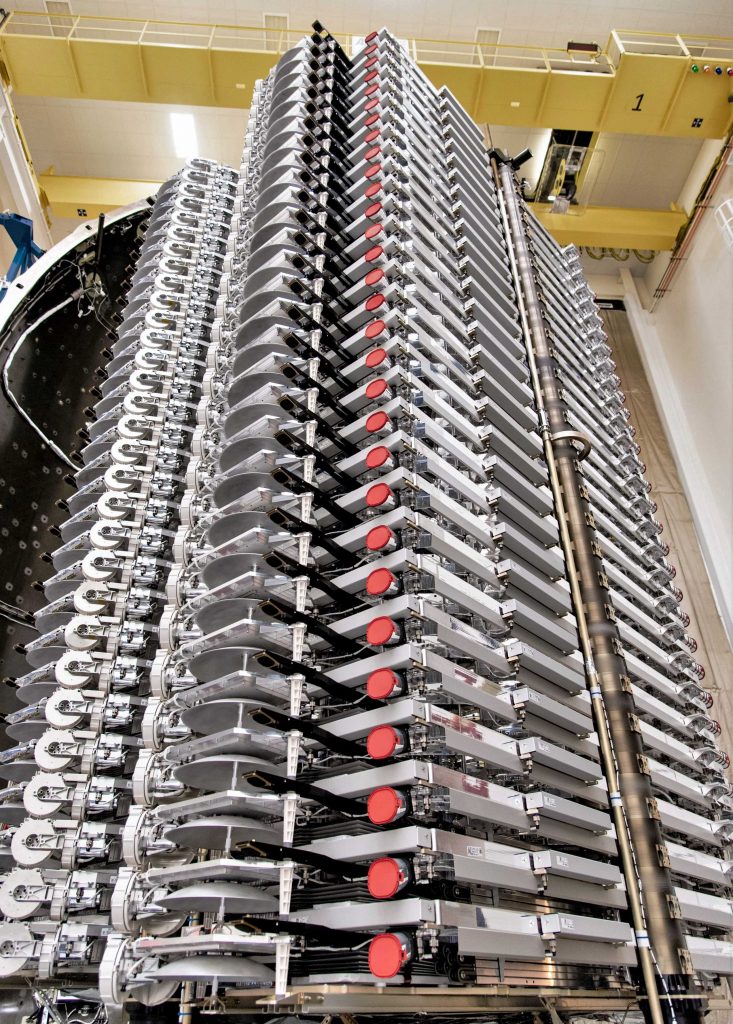
In a classic SpaceX move, the company’s Starlink satellite bus is a radical departure from all other commercial spacecraft, opting for a table-like rectangular shape that is extremely flat. While the rectangular shape – likely chosen for the extreme ease of manufacturing it should allow – significantly decreases packing efficiency, Starlink’s flat design and unique deployment mechanism means that SpaceX can fit an unprecedented 60 satellites (each weighing more than 250 kg or 550 lb) into a single lightly-modified Falcon 9 payload fairing.
Ultimately, SpaceX also design its Starlink satellites to be dramatically more robust than any comparable commercial spacecraft, meaning that they are meant to tolerate the violent acoustic launch environment without foam sound suppression panels that otherwise take up space inside Falcon 9’s fairing. Additionally, they are meant to survive the odd collision during their bizarre deployment, in which Falcon 9’s upper stage spins itself like a fan and releases the entire 60-satellite stack at once. Further, this means that Starlink satellites can be transported from their Washington state factory to Cape Canaveral, Florida far more easily and cheaply than almost any other spacecraft of a similar size and weight.
Falcon 9’s second fourth flight
It’s a mouthful, but SpaceX’s Starlink-2 mission will technically mark Falcon 9’s second fourth flight, meaning that it will be the second time a single Falcon 9 booster launches (and optimally lands) for the fourth time. Thrice-flown Falcon 9 booster B1049 has been assigned to support the launch.
The fourth completed Falcon 9 Block 5 booster, B1049 debuted on September 10th, 2018 on the Telstar 18V satellite launch, followed by a second flight (Iridium-8) in January 2019 and its third and most recent launch in May 2019. B1049’s most recent mission happened to be the very first dedicated Starlink launch, placing 60 Starlink v0.9 spacecraft in orbit in a sort of massive beta test of SpaceX’s cutting-edge satellite technology and design.
In support of Starlink V1 L1, the first launch of finalized Starlink v1.0 satellites, Falcon 9 booster B1048 became the first SpaceX rocket to successfully launch and land four times in November 2019, safely returning to shore aboard drone ship Of Course I Still Love You (OCISLY) a few days later. With (hopefully) two (and soon three) recovered boosters with four flights each under their belts, SpaceX will have a relative wealth of data it can then use to plot the way forward to fifth flights of boosters and beyond – halfway to the minimum Block 5 design goal of 10 launches apiece.
Teslarati photographer Richard Angle (@RDanglePhoto) will be on-site to capture SpaceX’s first Falcon 9 launch and booster recovery of the 2020s. Stay tuned for more details and photos as the launch nears!
Check out Teslarati’s Marketplace! We offer Tesla accessories, including for the Tesla Cybertruck and Tesla Model 3.
News
Tesla Semis to get 18 new Megachargers at this PepsiCo plant
PepsiCo is set to add more Tesla Semi Megachargers, this time at a facility in North Carolina.
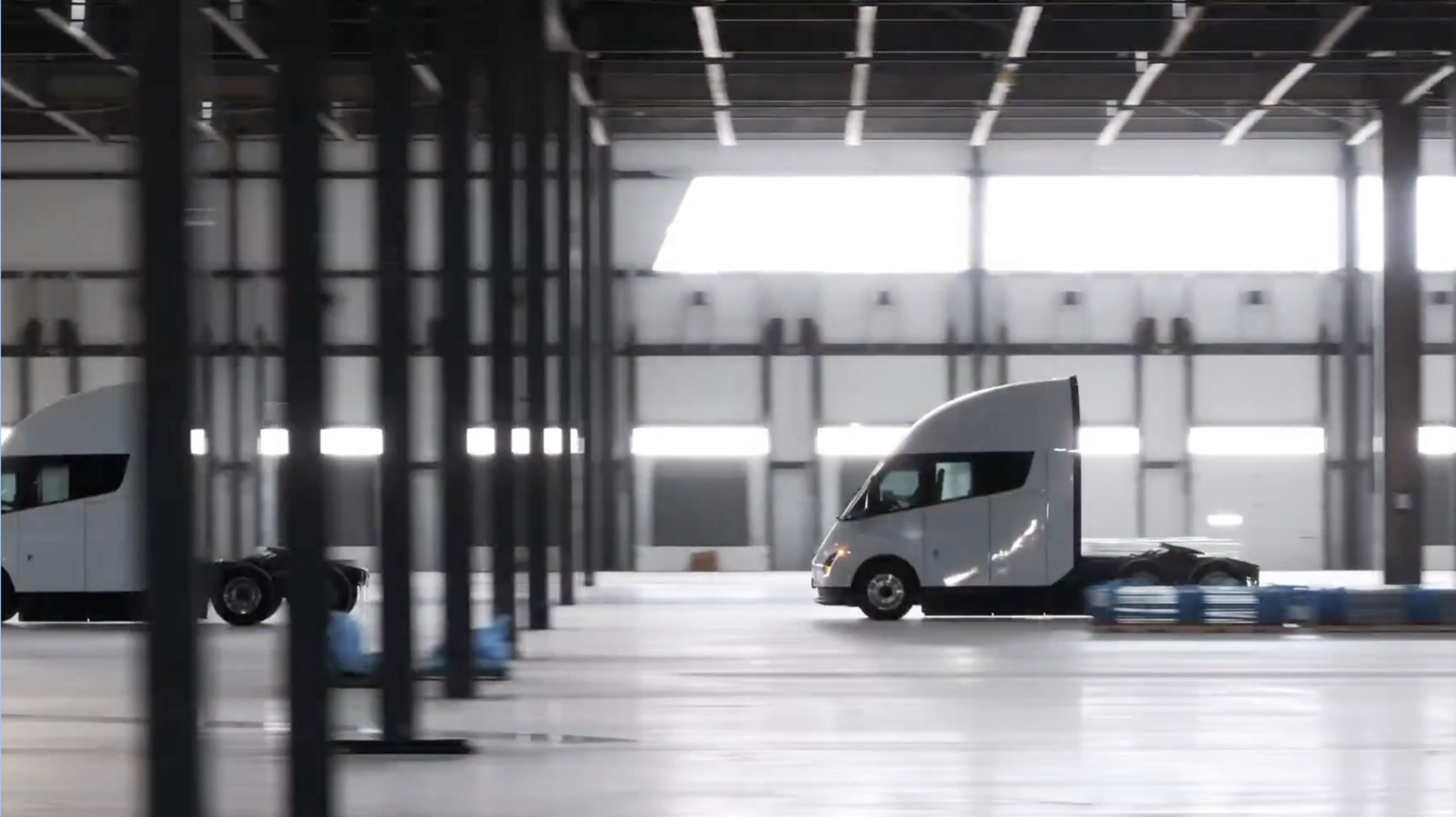
Tesla partner PepsiCo is set to build new Semi charging stations at one of its manufacturing sites, as revealed in new permitting plans shared this week.
On Friday, Tesla charging station scout MarcoRP shared plans on X for 18 Semi Megacharging stalls at PepsiCo’s facility in Charlotte, North Carolina, coming as the latest update plans for the company’s increasingly electrified fleet. The stalls are set to be built side by side, along with three Tesla Megapack grid-scale battery systems.
The plans also note the faster charging speeds for the chargers, which can charge the Class 8 Semi at speeds of up to 1MW. Tesla says that the speed can charge the Semi back to roughly 70 percent in around 30 minutes.
You can see the site plans for the PepsiCo North Carolina Megacharger below.
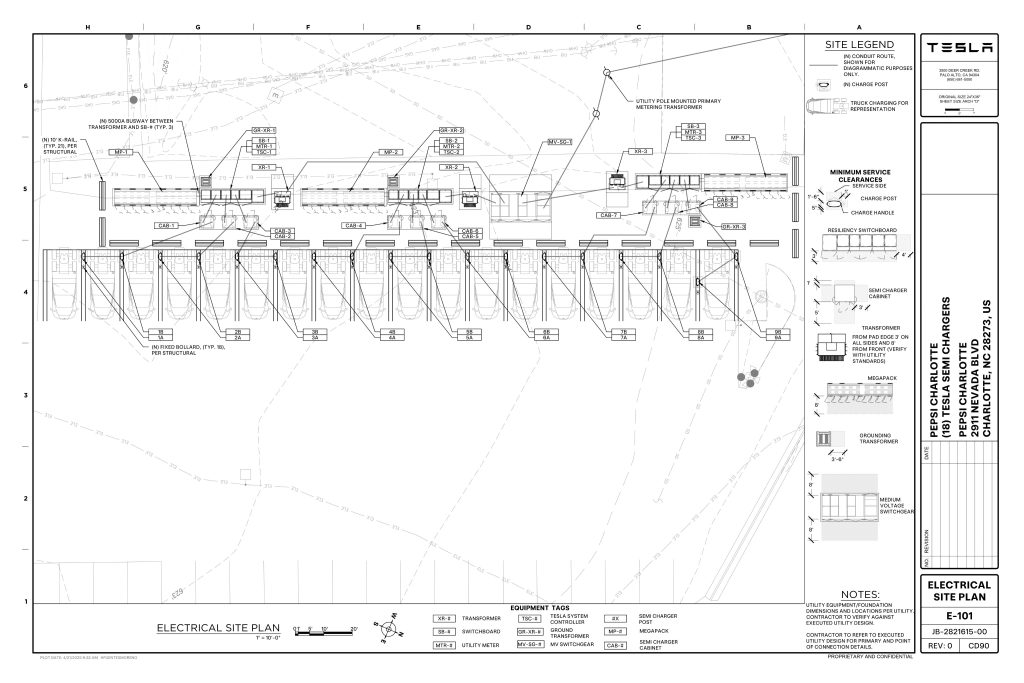
Credit: PepsiCo (via MarcoRPi1 on X)
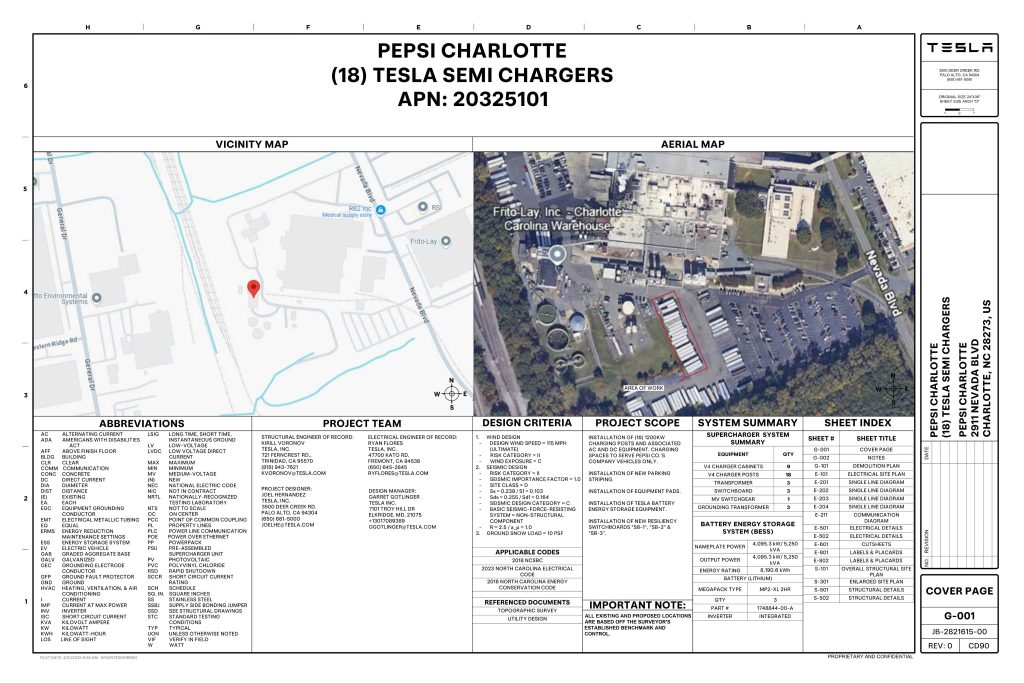
Credit: PepsiCo (via MarcoRPi1 on X)
READ MORE ON THE TESLA SEMI: Tesla to build Semi Megacharger station in Southern California
PepsiCo’s Tesla Semi fleet, other Megachargers, and initial tests and deliveries
PepsiCo was the first external customer to take delivery of Tesla’s Semis back in 2023, starting with just an initial order of 15. Since then, the company has continued to expand the fleet, recently taking delivery of an additional 50 units in California. The PepsiCo fleet was up to around 86 units as of last year, according to statements from Semi Senior Manager Dan Priestley.
Additionally, the company has similar Megachargers at its facilities in Modesto, Sacramento, and Fresno, California, and Tesla also submitted plans for approval to build 12 new Megacharging stalls in Los Angeles County.
Over the past couple of years, Tesla has also been delivering the electric Class 8 units to a number of other companies for pilot programs, and Priestley shared some results from PepsiCo’s initial Semi tests last year. Notably, the executive spoke with a handful of PepsiCo workers who said they really liked the Semi and wouldn’t plan on going back to diesel trucks.
The company is also nearing completion of a higher-volume Semi plant at its Gigafactory in Nevada, which is expected to eventually have an annual production capacity of 50,000 Semi units.
Tesla executive teases plan to further electrify supply chain
News
Tesla sales soar in Norway with new Model Y leading the charge
Tesla recorded a 54% year-over-year jump in new vehicle registrations in June.
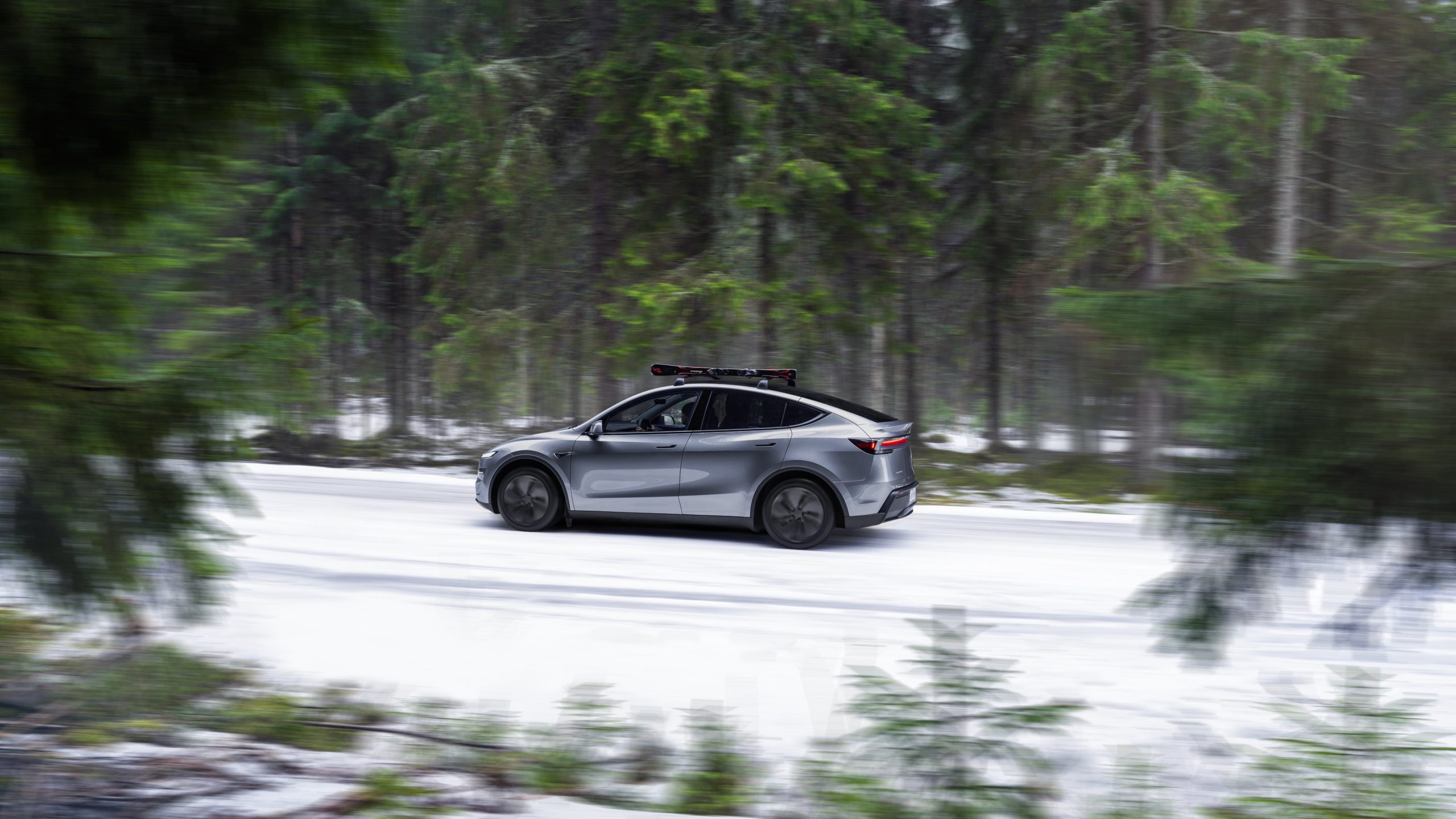
Tesla is seeing strong momentum in Norway, with sales of the new Model Y helping the company maintain dominance in one of the world’s most electric vehicle-friendly markets.
Model Y upgrades and consumer preferences
According to the Norwegian Road Federation (OFV), Tesla recorded a 54% year-over-year jump in new vehicle registrations in June. The Model Y led the charge, posting a 115% increase compared to the same period last year. Tesla Norway’s growth was even more notable in May, with sales surging a whopping 213%, as noted in a CNBC report.
Christina Bu, secretary general of the Norwegian EV Association (NEVA), stated that Tesla’s strong market performance was partly due to the updated Model Y, which is really just a good car, period.
“I think it just has to do with the fact that they deliver a car which has quite a lot of value for money and is what Norwegians need. What Norwegians need, a large luggage space, all wheel drive, and a tow hitch, high ground clearance as well. In addition, quite good digital solutions which people have gotten used to, and also a charging network,” she said.
Tesla in Europe
Tesla’s success in Norway is supported by long-standing government incentives for EV adoption, including exemptions from VAT, road toll discounts, and access to bus lanes. Public and home charging infrastructure is also widely available, making the EV ownership experience in the country very convenient.
Tesla’s performance in Europe is still a mixed bag, with markets like Germany and France still seeing declines in recent months. In areas such as Norway, Spain, and Portugal, however, Tesla’s new car registrations are rising. Spain’s sales rose 61% and Portugal’s sales rose 7% last month. This suggests that regional demand may be stabilizing or rebounding in pockets of Europe.
News
Tesla to open first India experience center in Mumbai on July 15
The event is scheduled for July 15 at the Bandra Kurla Complex, a premier business district in Mumbai.

Tesla is officially entering India with the opening of its first showroom and experience center in Mumbai next week. The event is scheduled for July 15 at the Bandra Kurla Complex, a premier business district in Mumbai.
Tesla imports to India signal an early-stage market entry strategy
According to Indian customs data, Tesla has imported approximately $1 million worth of vehicles, charging equipment, and merchandise into the country between January and June. The shipments include six Model Y comprised of five standard variants valued at $32,500 each and one long-range model valued at $46,000. Several Superchargers and related accessories were also imported into the country, as noted in a Yahoo Finance report.
These vehicles are expected to serve as display models and test units as Tesla gauges interest and navigates India’s high import duties, which hover around 70% on fully built vehicles. Despite the significant tariffs in the country, Tesla has opted to begin its India expansion with imported cars.
An invitation to the Tesla India launch event has been making the rounds online. As could be seen in the document, Tesla noted that July 15 would be the launch of Tesla in India through the opening of a Tesla experience centre at Bandra Kurla Complex in Mumbai.
Tesla India’s hiring and expansion efforts are underway
Tesla has filled a number of key roles from the 30+ positions it advertised earlier this year. Recent hires include store managers, service executives, and sales staff, while ongoing recruitment is focused on supply chain engineers and vehicle operators to support the company’s Autopilot program.
Indian officials have been open about their intention to encourage Tesla to establish a manufacturing hub in the country. Tesla does seem open to the idea, at least, with reports last year hinting that Elon Musk was set to visit the country to discuss or even potentially announce a domestic project. The trip, however, was ultimately canceled.
-

 Elon Musk2 weeks ago
Elon Musk2 weeks agoTesla investors will be shocked by Jim Cramer’s latest assessment
-

 Elon Musk1 day ago
Elon Musk1 day agoxAI launches Grok 4 with new $300/month SuperGrok Heavy subscription
-

 Elon Musk4 days ago
Elon Musk4 days agoElon Musk confirms Grok 4 launch on July 9 with livestream event
-

 News1 week ago
News1 week agoTesla Model 3 ranks as the safest new car in Europe for 2025, per Euro NCAP tests
-

 Elon Musk2 weeks ago
Elon Musk2 weeks agoA Tesla just delivered itself to a customer autonomously, Elon Musk confirms
-

 Elon Musk1 week ago
Elon Musk1 week agoxAI’s Memphis data center receives air permit despite community criticism
-

 News2 weeks ago
News2 weeks agoXiaomi CEO congratulates Tesla on first FSD delivery: “We have to continue learning!”
-

 News2 weeks ago
News2 weeks agoTesla sees explosive sales growth in UK, Spain, and Netherlands in June



















